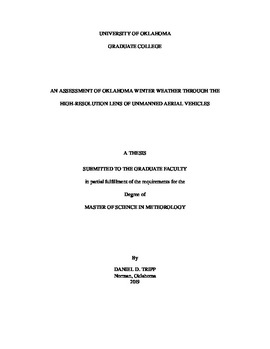| dc.description.abstract | Winter weather can lead to power grid failures, disruption of transportation, and can impact the local economy. Specifically in the southern Great Plains, short term model analyses struggle to identify the depth and magnitude of melting and refreezing layers associated with winter weather environments. Studies have shown that the temperature and humidity profiles in the lowest 3 km of the atmosphere provide crucial information in determining the precipitation type which aids forecasters in relaying winter weather risks. However, a change as little as 0.5 °C in the vertical profile has been found to alter the precipitation type observed at the surface. Therefore, this study employs unmanned aerial vehicles (UAVs) to explore the efficacy of high temporal and vertical measurements in winter weather environments.
A climatology of winter weather storm reports and associated boundary layer characteristics was compiled to gain a spatial understanding of winter weather precipitation types across the state of Oklahoma. The central/southwestern portions of the state are more prone to ice storms, whereas the northern portions of the state typically observe snow. During the 2018-2019 winter season, boundary layer measurements of an Oklahoma winter storm were collected by a UAV and radiosondes for the first time. The High Resolution Rapid Refresh (HRRR) model analyses resolved the melting and refreezing layer thicknesses well, but was 1-2 °C warmer than the UAV observations.
Using the spectral-bin classifier algorithm, it was found that UAV measurements can improve discrimination between hydrometer types in environments near 0 °C. A WRF modeling study of the same winter weather environment illustrated the growth and decay of melting and refreezing layers on hourly to sub-hourly temporal scales. Additionally, it was found that high horizontal variability can exist in melting and refreezing layers at a distance of 55 km. Therefore, considerations for precise UAV measurements in a statewide network are recommended as a new addition to our current observational network. | en_US |
